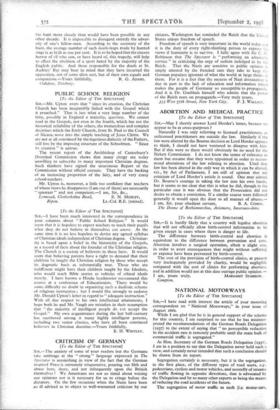THE DEATH OF A STAG
[To the Editor of THE SPECTATOR] SIR,—The death, at St. Audries' Bay, of a stag which leaped over a hundred-foot cliff to escape being torn to pieces by hounds of the Quantock hunt, filled eye-witnesses with a pity and horror that is shared by the general public. This reaction of repugnance is natural to any civilised man. It cannot be analysed, accounted for, or overruled by any argument. No amount of reasons in favour of hunting can really remove from the mind of the average man a resentment and sense of shame which spring fundamentally from his conscience.
It is noticeable that while people on the beach were overcome with anger and grief, the foremost members of the hunt dis- claimed any responsibility, while those actually out with hounds silently ignored the opposition of the onlookers. The behaviour of both parties is significant when considered in connexion with the tendencies of the present age.
Today, as modern writers and politicians are making increas- ingly clear, class cannot hold itself aloof from class. All classes feel a growing affinity with each other. The instinctive horror of those on the beach at St. Audries' concerned the members of
the hunt more closely than would have been possible in any other decade. It is impossible to disregard entirely the adver- sity of one's fellow-men. According to the secretary of the hunt, the average number of such death-leaps made by hunted stags is as high as one per cent. It is to be hoped that the sincere horror of ell who saw, or have heard of, this tragedy, will help to effect the abolition of a sport hated by the majority of the English public. And those responsible for the death at St. Audries' Bay may bear in mind that they have incurred the opposition, not of some alien sect, but of their own equals and companions.—Yours faithfully, R. G. ADAMS. Oakdene, Newbury.







































 Previous page
Previous page